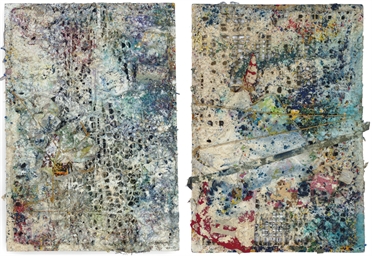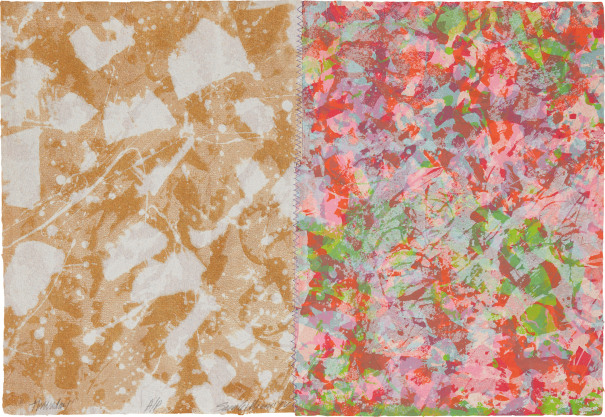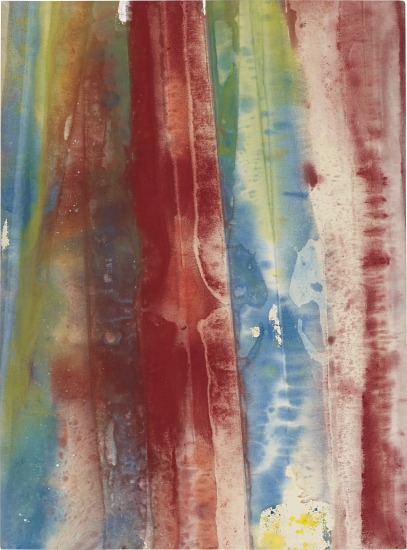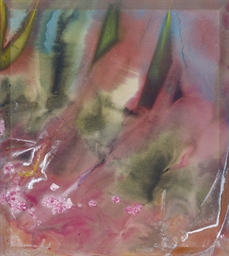138Sam GilliamUntitled, from VOICES: An Artists' Project1994 Mixed media painting, on Buckeye Ltd. paper. 11 x 14 in. (27.9 x 35.6 cm) Signed and numbered 82/100 in pencil (one of 100 unique works), published by The National Conference of Artists, Michigan Chapter, Detroit, framed. Estimate $4,000 - 6,000 Place Advance BidContact Specialist Editions@phillips.com
Condition ReportSign uporLog inCatalogue EssayThis work is one of Gilliam's contributions to VOICES, An Artists' Book created by 23 nationally known African American artists. It is a limited edition of 100 books each containing an original work by these artists. Sam first began experimenting with printmaking in the 1970s, first with his friend Lou Stoval and then, during the 1980s and onward, with Bill Weege at the Jones Road Press and then with Steve Anderson at Vermillion Press in Minneapolis. In John Beardsley's introduction to Sam Gilliam Recent Monoprints (Philadelphia: Brandy Wine Workshop, Printed Image Gallery, 1993) notes that "Weege encouraged him to freely to combine media and techniques, 'to work in the area between painting and prints, sculpture and prints" (p. 8) and goes on to add, "There is almost no way to reconstruct the creation of these prints, so many were the means. They began with handmade paper, sometimes two or three sheets combined. Some of these were taken from the traditional printer's inventory: woodblock, drawn and routed with circular shapes… But others were more unorthodox: objects discovered at a foundry were freely use, including a variety of stencils and even metal shavings. The shapes of still other found objects were embossed directly into the paper…Gilliam then took these prints back to his studio, cut them apart again and stitched them back together—much as he does with his paintings—using heavy nylon filament. Both before and after this collaging, he raked acrylic and gel across the prints; he then printed them yet again. This is Gilliam the printmaker at his most impulsive, even whimsical—the organizing geometry has been reduced to just an arc here, a rectangle there; drawing is loose, and colors are vibrant. In all there is a brightness and freshness…that can be directly attributed to their exuberant technique" (pp. 9-19). Or as Bill Weege would say, "Just do it."Read MoreArtist BioSam GilliamAmerican • 1933 Follow “At Age 84, ‘Living Legend’ Sam Gilliam Is Enjoying His Greatest Renaissance Yet” – so read the headline of a January 2, 2018 artnet article covering the all-time high of Sam Gilliam’s critical and market attention. More than 40 years years since Gilliam became the first African American artist to represent the United States at the Venice Bienniale in 1972, the abstract painter’s career has been catapulted to widespread acclaim. In 2016, a major new commission, Yet I Do Marvel, debuted in the lobby of the highly anticipated National Museum of African American History and Culture in his hometown of Washington, DC, and in 2017 he made his return to the Venice Biennale with his brilliantly colored, unstretched canvas Yves Klein Blue that welcomed visitors to the Giardini’s main pavilion. Most recently, his work has been included in Soul of A Nation: Art in the Age of Black Power, the landmark exhibition organized by the Tate Modern, London, that will travel to the Broad Museum in Los Angeles after closing at the Brooklyn Museum in February 2019. Gilliam’s innovations from the late 1960s and early 1970s cemented his reputation as one of the most preeminent artists associated with the Washington Color School. Characteristically pushing his medium to its very limits, Gilliam experimented with color, process and materiality like earlier Color Field artists Morris Louis and Kenneth Noland but took a radically different path in his dismantling of the canvas stretcher. He first rose to fame in the late 1960s with his drape paintings, which came out of his experiments with unsupported canvases – works he said were partly inspired by watching women hang laundry on clotheslines from his studio window in Washington, DC. In 1967, he began creating his slices, or bevelled-edge paintings, which saw him pour paint onto unstretched and unprimed canvases and then fold and crumple the fabric before stretching it on a frame. Since then, he has produced considerable bodies of work, ranging from
138Sam GilliamUntitled, from VOICES: An Artists' Project1994 Mixed media painting, on Buckeye Ltd. paper. 11 x 14 in. (27.9 x 35.6 cm) Signed and numbered 82/100 in pencil (one of 100 unique works), published by The National Conference of Artists, Michigan Chapter, Detroit, framed. Estimate $4,000 - 6,000 Place Advance BidContact Specialist Editions@phillips.com
Condition ReportSign uporLog inCatalogue EssayThis work is one of Gilliam's contributions to VOICES, An Artists' Book created by 23 nationally known African American artists. It is a limited edition of 100 books each containing an original work by these artists. Sam first began experimenting with printmaking in the 1970s, first with his friend Lou Stoval and then, during the 1980s and onward, with Bill Weege at the Jones Road Press and then with Steve Anderson at Vermillion Press in Minneapolis. In John Beardsley's introduction to Sam Gilliam Recent Monoprints (Philadelphia: Brandy Wine Workshop, Printed Image Gallery, 1993) notes that "Weege encouraged him to freely to combine media and techniques, 'to work in the area between painting and prints, sculpture and prints" (p. 8) and goes on to add, "There is almost no way to reconstruct the creation of these prints, so many were the means. They began with handmade paper, sometimes two or three sheets combined. Some of these were taken from the traditional printer's inventory: woodblock, drawn and routed with circular shapes… But others were more unorthodox: objects discovered at a foundry were freely use, including a variety of stencils and even metal shavings. The shapes of still other found objects were embossed directly into the paper…Gilliam then took these prints back to his studio, cut them apart again and stitched them back together—much as he does with his paintings—using heavy nylon filament. Both before and after this collaging, he raked acrylic and gel across the prints; he then printed them yet again. This is Gilliam the printmaker at his most impulsive, even whimsical—the organizing geometry has been reduced to just an arc here, a rectangle there; drawing is loose, and colors are vibrant. In all there is a brightness and freshness…that can be directly attributed to their exuberant technique" (pp. 9-19). Or as Bill Weege would say, "Just do it."Read MoreArtist BioSam GilliamAmerican • 1933 Follow “At Age 84, ‘Living Legend’ Sam Gilliam Is Enjoying His Greatest Renaissance Yet” – so read the headline of a January 2, 2018 artnet article covering the all-time high of Sam Gilliam’s critical and market attention. More than 40 years years since Gilliam became the first African American artist to represent the United States at the Venice Bienniale in 1972, the abstract painter’s career has been catapulted to widespread acclaim. In 2016, a major new commission, Yet I Do Marvel, debuted in the lobby of the highly anticipated National Museum of African American History and Culture in his hometown of Washington, DC, and in 2017 he made his return to the Venice Biennale with his brilliantly colored, unstretched canvas Yves Klein Blue that welcomed visitors to the Giardini’s main pavilion. Most recently, his work has been included in Soul of A Nation: Art in the Age of Black Power, the landmark exhibition organized by the Tate Modern, London, that will travel to the Broad Museum in Los Angeles after closing at the Brooklyn Museum in February 2019. Gilliam’s innovations from the late 1960s and early 1970s cemented his reputation as one of the most preeminent artists associated with the Washington Color School. Characteristically pushing his medium to its very limits, Gilliam experimented with color, process and materiality like earlier Color Field artists Morris Louis and Kenneth Noland but took a radically different path in his dismantling of the canvas stretcher. He first rose to fame in the late 1960s with his drape paintings, which came out of his experiments with unsupported canvases – works he said were partly inspired by watching women hang laundry on clotheslines from his studio window in Washington, DC. In 1967, he began creating his slices, or bevelled-edge paintings, which saw him pour paint onto unstretched and unprimed canvases and then fold and crumple the fabric before stretching it on a frame. Since then, he has produced considerable bodies of work, ranging from








.jpg)


.jpg)



Try LotSearch and its premium features for 7 days - without any costs!
Be notified automatically about new items in upcoming auctions.
Create an alert